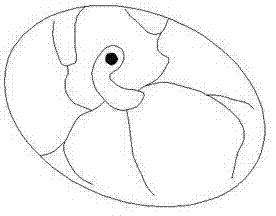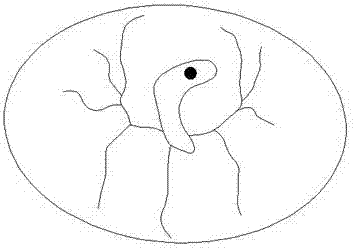Method forlossless determination of genders of poultry embryo eggs
A judging method and sex technology, applied in the field of poultry breeding, can solve problems such as poor repeatability, roughness, and inconvenient operation, and achieve the effects of saving hatching costs, improving production efficiency, and facilitating production application and promotion
- Summary
- Abstract
- Description
- Claims
- Application Information
AI Technical Summary
Problems solved by technology
Method used
Image
Examples
Embodiment 1
[0084] Embodiment one: chicken embryo egg
[0085] As attached to the manual figure 1 As shown, after sterilizing the same batch of 40 breeding eggs according to the conventional technical requirements, pre-incubate them at 28°C for about 4 hours to make the embryo eggs evenly heated, and then adjust to 38°C with a relative humidity of 60% for incubation. Gender determination is carried out at 104 hours. First place the embryonated egg on its side for 5 minutes, and use a LED flashlight to stick to the embryonic egg for inspection. After removing the infertile eggs and dead embryonated eggs, conduct gender determination with the standard position of head up and tail down. , the accuracy rate is 78.26%. Among them, the instruction manual image 3 It is a schematic diagram of the blood line of a male chicken embryo egg, and the manual is attached Figure 4 It is a schematic diagram of the blood line of a female chicken embryo egg, which can be found in the appendix of the man...
Embodiment 2
[0087] Embodiment two: duck embryo eggs
[0088] As attached to the manual figure 1 As shown, after disinfecting the same batch of 40 breeding duck eggs according to the conventional technical requirements, they were pre-incubated at 28°C for about 4 hours so that the embryo eggs were evenly heated, and then adjusted to 38°C with a relative humidity of 60% for incubation. Gender determination is carried out at 120 hours. First, place the embryonated egg on its side for 4 minutes, and use a LED flashlight to stick to the embryonic egg for inspection. After removing the infertile eggs and dead embryonated eggs, conduct gender determination with the standard position of head up and tail down. The accuracy rate is 85.26%. Among them, the instruction manual Figure 5 It is a schematic diagram of the blood line of a male duck embryo egg, and the instructions are attached Image 6 It is a schematic diagram of the blood line of a female duck embryo egg, which can be found in the ap...
Embodiment 3
[0090] Embodiment three: pigeon embryo egg
[0091] As attached to the manual figure 1 As shown, after disinfecting the same batch of 40 breeding pigeon eggs according to the conventional technical requirements, they were pre-incubated at 28°C for about 4 hours to make the embryo eggs evenly heated, and then adjusted to 38.5°C and 60% relative humidity for incubation. Gender determination is carried out at 96 hours of incubation. First, place the embryonic egg on its side for 8 minutes, and use a LED flashlight to stick to the embryonic egg for inspection. After removing the infertile eggs and dead embryonated eggs, conduct gender determination with the standard position of head up and tail down. , with an accuracy rate of 86.5%. Among them, the instruction manual Figure 7 It is a schematic diagram of the blood line of male pigeon embryo eggs, and the instructions are attached Figure 8 It is a schematic diagram of the blood line of the embryonic eggs of female pigeons, wh...
PUM
 Login to View More
Login to View More Abstract
Description
Claims
Application Information
 Login to View More
Login to View More - R&D
- Intellectual Property
- Life Sciences
- Materials
- Tech Scout
- Unparalleled Data Quality
- Higher Quality Content
- 60% Fewer Hallucinations
Browse by: Latest US Patents, China's latest patents, Technical Efficacy Thesaurus, Application Domain, Technology Topic, Popular Technical Reports.
© 2025 PatSnap. All rights reserved.Legal|Privacy policy|Modern Slavery Act Transparency Statement|Sitemap|About US| Contact US: help@patsnap.com



